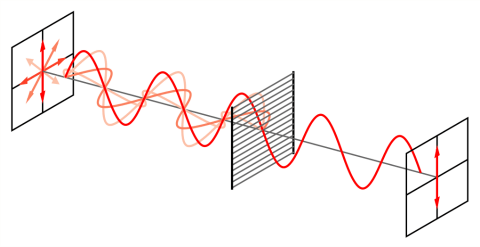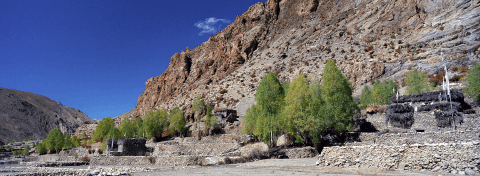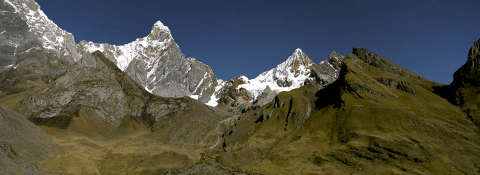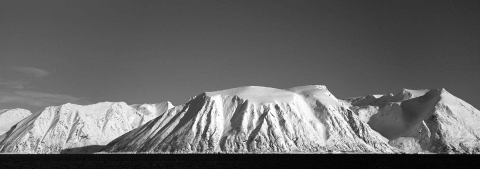Giving direction to light: How to use a polarising filter
A polarising filter, also called polariser, or just "pol", as many photographers refer to it, is somewhat akin to a double-edged sword. When used in excess, it quickly becomes tedious. On the other hand, applied with consideration, it can produce some striking results unattainable by other means.
You may want to rotate your phone in order to improve your browsing experience on this site.
Quick links
How it works
If you ever tried a pair of polarising sunglasses on, you already know what to expect from a polarising filter, as both work in a similar way.
The explanation below might be a bit tough to grasp, but knowing the principles at work behind the scenes will give you a better understanding of how to make them work to your advantage. Try to hang on, but feel free to skip to the next section whenever you think you've had enough.
The idea behind the polariser is based on the fact that light waves reflected off any non-metallic surface start oscillating – you could also say bouncing – in one plane. Physicists speak of the light becoming linearly polarised.
It's just occurred to me that "plain light" would have been just as fine a metaphor, perhaps less academic but all the same.
The composite light entering the camera, being reflected off different objects before its lens, will still comprise waves from multiple polarisation planes and, as such, remain unpolarised.
Now, imagine a filter made to only let through the light polarised in one direction. Aligned with a particular polarisation plane, the filter won't affect the light polarised along this plane's surface. However, light from other polarisation planes will get partially trapped by the filter, to a degree depending on the angle between their planes. Light from the plane perpendicular to the direction of the filter won't pass through the latter at all.
All light behind such a filter will, by design, have the same polarisation plane and thus become perfectly polarised.
In theory, an ideal linear polariser placed perpendicular to a beam of unpolarised light will let only half the light amount through. Hence, a polarising filter will require exposure compensation by at least 1 EV. In real life, this value is even higher.
 A wire-grid polariser converting unpolarised light
A wire-grid polariser converting unpolarised lightSee the aside below for explanations
The illustration above shows a wire-grid polariser consisting of parallel metallic wires. Though not optical in nature, it lets through without loss only the light polarised in the direction perpendicular to that of both grid's plane and wires' orientation.
The figure doesn't make clear that vertical components of light waves from other polarisation planes also get through, while their horizontal segments are absorbed or reflected.
That's it! The whole process can be briefly described as follows:
- The unpolarised sunlight gets scattered and reflected, breaking into multiple waves polarised in different directions.
- A dedicated filter lets only those components of the waves through, which coincide with the polarising direction of the filter.
- Other components of light waves get absorbed or reflected.
A typical polarising filter consists of two glass plates. The outer one is made of linearly polarised glass and rotates to position its polarisation plane. The inner plate is a fixed circular polariser which further filters the light before it enters the lens.
The last step is meant to prevent auto-focus and metering problems with some camera models.
To sum it up
- A polarising filter selectively lets light of specific wavelengths through while absorbing other light waves at different rates. Polarisation plane perpendicular to the direction of the filter is for the most part prevented from entering the camera.
- As a consequence, several colour ranges end up particularly darkened.
- Another result is the diminished glare and reflections from non-metallic surfaces. Their colour will appear partially revealed in the final image.
- The same goes for reflections when photographing through water or glass. Arm your camera with a polariser if you aim for an unobstructed view of what lies behind.
 Exploding sky • Along the coast of Greenland, North Atlantic
Exploding sky • Along the coast of Greenland, North AtlanticReflections off water reduced by polariser
- An obvious implication of less light entering the camera is the reduced exposure value – by up to 3 EV – which has to be compensated by slower shutter speed or increased ISO.
I silently assume, you all shoot with aperture priority by now :)
- A less obvious one is heavy vignetting, that is, darkening of the corners of the image, particularly when working with wide-angle lenses.
When to use a polarising filter
The filter is by no means confined to landscape photography alone. However, its effect on landscape images is arguably most dramatic.
As I mention in the introduction article, I wouldn't recommend using it more often than just once in a while, let alone leaving it in front of your lens on a regular basis. There are situations, however, when using the filter is well worth considering.
Shooting into the sun. Using a polariser on a bright summer day can help you with several issues at once.
- When positioned to its full effect, the filter will reduce exposure value by some 3 EV, with most darkening applied to the sky – exactly where it's most needed to prevent overexposure
- Sunlight reflected from water/snow/sand/foliage will be softened, thus avoiding blown highlights here, too
- You'll be able to open up the lens to, say, more comfortable f11 instead of f32
Shooting through glass/water. If you hope to see something behind a mirror-like surface rather than everything in front of it reflected, including yourself taking a picture, try a polarising filter. Again, the outcome stands and falls with the exact positioning, but it's really your only chance.
To get the maximum effect,
- allow the sun to rise sufficiently above the horizon. The filter is of no practical use at sunrise or sunset. At this time of the day, lighting rarely requires enhancements anyway.
At noon, the sun is too high to get a strong effect from the filter. Late morning and mid-afternoon are your best choices. - turn to have the sun shining from your side. The filter is at most effective with its surface parallel to the direction of sunlight. Roughly about 15°-30° to both sides of the optimal direction, i.e., with the sun exactly to either your left or right, is your degree of freedom.
- rotate the outer plate and observe the effect in the viewfinder – using an LCD under lighting conditions calling for a polariser could be challenging.
To assess the effect of the polarising filter on your intended image, you need an SLR camera or a LiveView display usable in bright sunlight. I have no idea if there still are rangefinder cameras around, but a solution is available for them, too. Kenko Tokina continue producing graduated polarising filters sold with a separate finder. Both pieces are equipped with the same numeric scale. The hand-held or hotshoe-mounted finder is rotated until the desired effect is achieved, after which its scale reading is applied to the main filter attached to the lens. The polariser for my XPan is of this same variety.
Simulating a polariser in Photoshop
With the abundance of photography filters available for imitation in Photoshop, the absence of the polariser is rather noticeable. The reason is simple: cameras don't record the information about light polarisation at the shooting scene, so it's impossible to accurately reproduce the effect a polarising filter might have had on the image.
Some tricks are still at hand. Since the filter mainly affects the blues and the greens, isolating the red channel from the image already makes a really good approximation.
If you are after a colour image with the similar effect, a few more steps are required. Here's how:
- Start with isolating the red channel. In the layer palette, change to the channel view, select the red channel and copy it.
- Duplicate the background layer.
- Convert the background copy to Lab mode (Image > Mode > Lab). Do not flatten the image.
- Now, in the channel view, select the lightness channel and paste the original red channel into it.
- Convert the layer back to RGB (Image > Mode > RGB). Once again, don't flatten the image.
This already brings the blues and the greens close to the state we aim to achieve. You can stop here if you are satisfied with the result. The modified lightness, however, will have affected the reds as well. To rectify this, a little more work is needed. - Add an empty mask to the working layer. Make sure the mask is selected in the layer overview.
- Now use the red channel from the background to mask itself. Choose Image > Apply Image, or Image > Calculations in older Photoshop versions. In the dialog, select Background and its red channel as the source, either Normal or Multiply as the blending option, and 100% as Opacity. Tick Invert. The latter will ensure that the mask will have the stronger an effect the brighter the red component is in the original image. Thus, our changes to the lightness channel will work selectively where we want them most, that is, specifically for blues and greens.
As you can imagine, these actions never lead to the same outcome a real polariser achieves for reflections and glare.
 Spellbound • Øfjord, Scoresby Sund, Greenland
Spellbound • Øfjord, Scoresby Sund, GreenlandPolarising effect added in Photoshop – see original in the slideshow
Need one?
Browse polarizing filters on Amazon.com
Browse polarizing filters on Amazon.ca
Browse polarising filters on Amazon.co.uk
Tags: #polarizer #lensfilters #photogear
Other landscape photography equipment
- Cameras best suited for landscape photography
- Following the thread about what is most important for landscape photography equipment, let's discuss some worthwhile options.
- Landscape photography ♥ panoramic cameras
- Ever wanted to try one? Read about your current options!
- How to choose a camera lens
- Everything you need to know when looking for a new camera lens, in one place: manufacturers, mounts, formats, types, and how to understand all those mystic lens labels.
- Understanding digital camera lenses – and their reviews
- Understand how to tell good digital camera lenses from the rest when reading their reviews.
- Best camera lenses for landscape photography
- The last article on camera lenses presents some fine choices for selected cameras.
- Filters for landscape photography
- Learn how to use most useful landscape photography filters!
- Polarising filter
- One of the most striking photography filters available is hard to imitate and easy to master. Try it!
Tell me what you think!
Is it useful 👍? Awful 👎? Leave a message! Your comments help make this site better (and give me a kick—one way or another).
Popular articles
-
A kind of magic
If a digital picture has to be seen in the real world, printed on a real medium and displayed in a real showcase, its transition from RAW to real is better done in an old school image editor. Enter A…
-
A duck for a dog
If you got your own place on the Internet, helping your visitors find what they are looking for is a great way to engage them and keep them staying a bit longer. A custom site search can achieve just …
-
"Might as well have the best"
Aiming for better images? Think better lenses! This is your most important piece of gear, so you better get it sorted out. — Need some advice?



 Become a patron for
Become a patron for